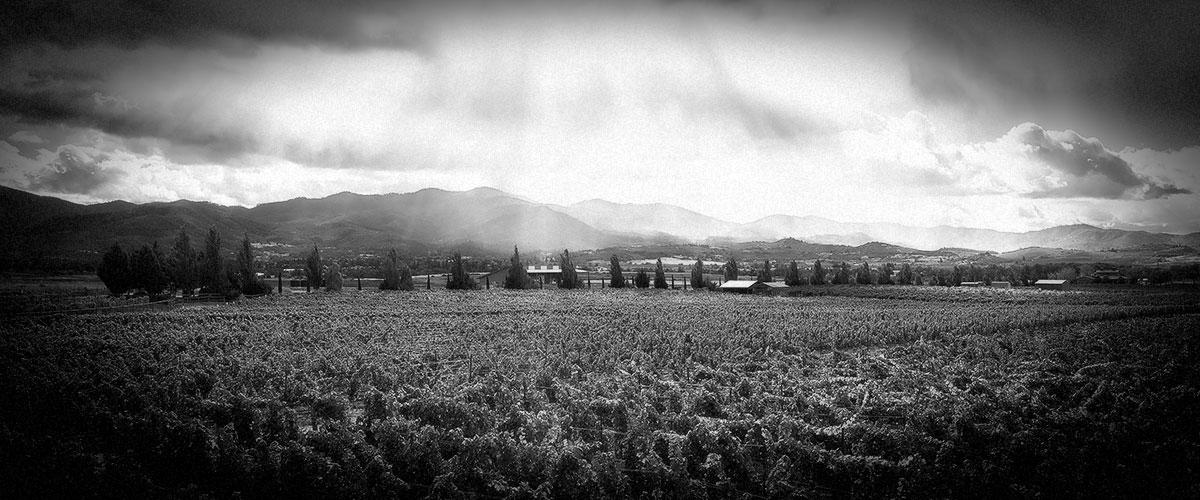by Chris Russell, Contributor
In the 2Hawk vineyard, summer means shaping and forging the vintage so it can reach its greatest potential. With fruit ripening on the vines and warm temperatures in the air, the vineyard is in full swing, requiring tremendously detailed work to ensure the best possible quality at harvest. This exhausting time of year has its challenges, but it’s also an important time to foster the health, vitality, and unique character of the vineyard.
A Pattern of Growth
The growth of each year’s vintage is marked by four critical periods: bud break, bloom, veraison, and harvest. Bud break and bloom occur in the spring, while harvest happens in the fall. The pivotal event of summer is veraison, when the vines shift their focus from the vegetative growth cycle (shoots and leaves) to the reproductive cycle (grapes).
By the start of summer, fruit set has already occurred as tiny green grapes are just becoming visible on the vines. During this critical time, we carefully manage vine nutrient and water status to keep the vineyard healthy and productive. As summer progresses, we prune and trim excess growth, encouraging the vines to dedicate their limited resources to ripening the fruit. We remove leaves to ensure the young grapes receive sufficient sunlight exposure and air is able to freely circulate through the vineyard’s canopy. We also remove some clusters of grapes to maximize fruit quality.
Not surprisingly, weather plays a vital role in the vineyard in the early summer. The growing vines need ample sunlight, nutrients, water, and warmth to sustain healthy growth. Overcast skies and rain can sometimes spell trouble in the form of mold and other fungal diseases. Even worse, hail can devastate a vineyard and its crop. Fortunately, excessive rain and hail are rare in the Rogue Valley during summer, one of the many reasons we’re thrilled to call Southern Oregon home.
Veraison
Up until this point, the growing grapes are green in color. In early August, however, they begin to change. The seeds become firm, the pulp softens, and—in the case of the red varieties—the grape skin begins to exhibit color, initially taking on a light red and then darker blue/black hues as the fruit matures. This process, called “veraison,” marks the beginning of maturity for the developing crop.
After veraison, the grapes become softer, sweeter, and less acidic. Anthocyanins, key to the color and antioxidative properties of red wine, begin forming. There may still be quite a long way to go until harvest, but the young crop is beginning to mature.
Challenges Met
Veraison marks the arrival of new challenges as well. As harvest draws near, the maturing grapes become increasingly attractive to pests such as insects, rodents, and birds. We must constantly watch the vineyard to prevent these uninvited guests from damaging the crop.
Watering is also crucial both during and after veraison. The vines struggling to ripen their grapes need more water from the soil than ever to sustain the process, so soil moisture levels must be monitored closely. Too much water can invite dilution of the grape’s aromas and flavors. Too little may prevent the crop from reaching its peak potential.
The maturing grapes also become more sensitive to weather conditions as fall approaches. Presenting another Goldilocks challenge, too much or too little heat can cause the grapes to ripen too quickly or slowly, altering the delicate balance of flavors in the developing fruit. Rain during this sensitive time can cause the grapes to absorb excessive moisture, diluting the character of the fruit or potentially causing the fruit to split open, which invites microbial contamination of the fruit before it can be successfully harvested.
2Hawk manages vineyard challenges in a variety of ways. Ross Allen, co-owner and vineyard manager of 2Hawk, insists on maintaining a cleanly cultivated vineyard floor, which keeps the soil healthy and, most importantly, minimizes competition for water and nutrients.
Ross also uses a sophisticated digital monitoring system to oversee weather and soil conditions throughout the vineyard, allowing him to make real-time adjustments to growing conditions from his phone or tablet. There’s ultimately no substitute for time spent in the vineyard, especially as harvest draws near, so that’s where you’ll find Ross more often than not, keeping close tabs on each vine and the health of the vineyard as a whole.
Ross notes that spending time in the field “gives you an opportunity to see what’s going on with each individual plant—not only from a water-stress standpoint, but from an overall vine health point of view.”
Learn More
We hope you found this glimpse into our vineyard during the summer informative. Careful management of the vineyard and thoughtful stewardship of the land are essential to bringing out the fullest potential in our estate fruit and handcrafted wines. If you’d like to learn more about what makes 2Hawk special, why not visit our tasting room or order one of our wines for yourself? Do you have any questions about our vineyard, our wines, or the winemaking process? If so, please comment below or reach out to us directly via our Contact page. We’d love to hear from you!
Meanwhile, if you’d like to learn more about Rogue Valley wines, here are a few ways:
- Why do we produce the wines we do? Find out in our recent post, The Why of Tempranillo.
- Visit the tasting room to sample our current wines.
- Follow us on Facebook and Instagram to keep up with the latest happenings.

